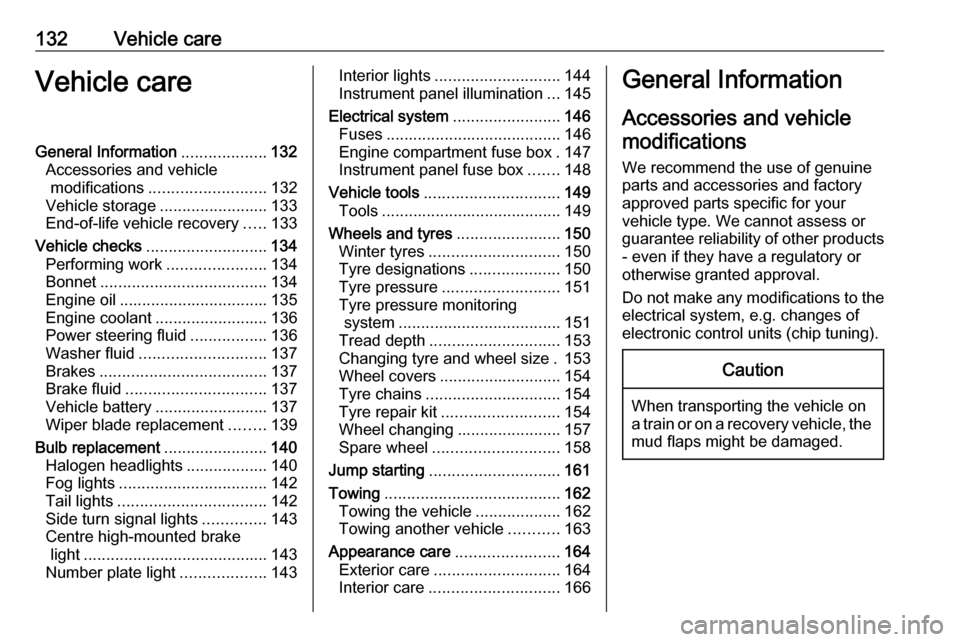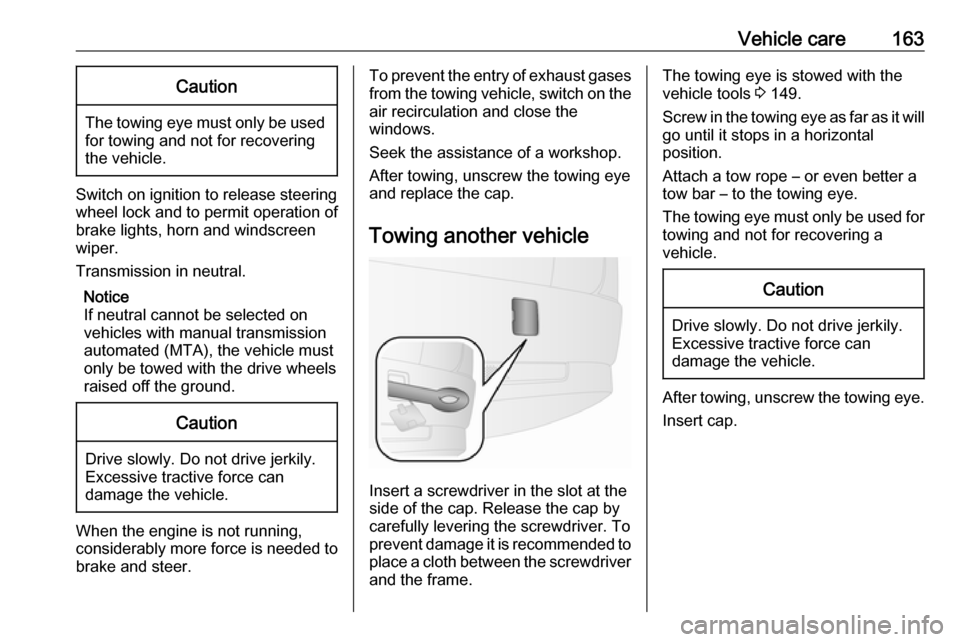steering VAUXHALL COMBO 2016 Owner's Guide
[x] Cancel search | Manufacturer: VAUXHALL, Model Year: 2016, Model line: COMBO, Model: VAUXHALL COMBO 2016Pages: 189, PDF Size: 4.47 MB
Page 132 of 189

130Driving and operatingTrailer hitch
General information
Only use towing equipment that has
been approved for your vehicle.
Vehicles with natural gas engine may
require special towing equipment.
Entrust retrofitting of towing
equipment to a workshop. It may be
necessary to make changes that
affect the cooling system, heat
shields or other equipment.
Fitting of towing equipment could
cover the opening of the towing eye.
If this is the case use the coupling ball bar for towing. Always keep the
coupling ball bar in the vehicle.
Driving characteristics and towing tips
Before attaching a trailer, lubricate the coupling ball. However, do not do so if a stabiliser, which acts on the
coupling ball, is being used to reduce
snaking movements.For trailers with low driving stability
and caravan trailers with a permitted
gross vehicle weight of more than
1300 kg the use of a stabiliser is
strongly recommended when driving
above 50 mph.
If the trailer starts snaking, drive more slowly, do not attempt to correct the
steering and brake sharply if
necessary.
When driving downhill, drive in the
same gear as if driving uphill and
drive at a similar speed.
Adjust tyre pressure to the value
specified for full load 3 179.
Trailer towing
Trailer loads The permissible trailer loads are
vehicle and engine-dependent
maximum values which must not be
exceeded. The actual trailer load is the difference between the actual
gross weight of the trailer and the
actual coupling socket load with the
trailer coupled.The permissible trailer loads are
specified in the vehicle documents. In general, they are valid for gradients
up to max. 12%.
The permitted trailer load applies up
to the specified incline and up to an
altitude of 1000 metres above sea
level. Since engine power decreases
as altitude increases due to the air
becoming thinner, therefore reducing
climbing ability, the permissible gross
train weight also decreases by 10% for every 1000 metres of additional
altitude. The gross train weight does
not have to be reduced when driving
on roads with slight inclines (less than
8%, e.g. motorways).
The permissible gross train weight
must not be exceeded. This weight is specified on the identification plate
3 170.
Vertical coupling load
The vertical coupling load is the load
exerted by the trailer on the coupling
ball. It can be varied by changing the
weight distribution when loading the
trailer.
Page 134 of 189

132Vehicle careVehicle careGeneral Information...................132
Accessories and vehicle modifications .......................... 132
Vehicle storage ........................133
End-of-life vehicle recovery .....133
Vehicle checks ........................... 134
Performing work ......................134
Bonnet ..................................... 134
Engine oil ................................. 135
Engine coolant ......................... 136
Power steering fluid .................136
Washer fluid ............................ 137
Brakes ..................................... 137
Brake fluid ............................... 137
Vehicle battery ......................... 137
Wiper blade replacement ........139
Bulb replacement .......................140
Halogen headlights ..................140
Fog lights ................................. 142
Tail lights ................................. 142
Side turn signal lights ..............143
Centre high-mounted brake light ......................................... 143
Number plate light ...................143Interior lights ............................ 144
Instrument panel illumination ...145
Electrical system ........................146
Fuses ....................................... 146
Engine compartment fuse box . 147
Instrument panel fuse box .......148
Vehicle tools .............................. 149
Tools ........................................ 149
Wheels and tyres .......................150
Winter tyres ............................. 150
Tyre designations ....................150
Tyre pressure .......................... 151
Tyre pressure monitoring
system .................................... 151
Tread depth ............................. 153
Changing tyre and wheel size . 153 Wheel covers ........................... 154
Tyre chains .............................. 154
Tyre repair kit .......................... 154
Wheel changing .......................157
Spare wheel ............................ 158
Jump starting ............................. 161
Towing ....................................... 162
Towing the vehicle ...................162
Towing another vehicle ...........163
Appearance care .......................164
Exterior care ............................ 164
Interior care ............................. 166General Information
Accessories and vehiclemodifications
We recommend the use of genuine
parts and accessories and factory
approved parts specific for your
vehicle type. We cannot assess or guarantee reliability of other products
- even if they have a regulatory or
otherwise granted approval.
Do not make any modifications to the
electrical system, e.g. changes of
electronic control units (chip tuning).Caution
When transporting the vehicle on
a train or on a recovery vehicle, the
mud flaps might be damaged.
Page 138 of 189

136Vehicle careEngine coolantThe coolant provides freeze
protection down to approx. -28 °C. In
northern countries with very low
temperatures, the factory filled
coolant provides frost protection
down to approx. -37 °C.Caution
Only use approved antifreeze.
Coolant level
Caution
Too low a coolant level can cause engine damage.
If the cooling system is cold, the
coolant level should be between the
MIN and MAX mark. Top up if the
level is low.
9 Warning
Allow the engine to cool before
opening the cap. Carefully open
the cap, relieving the pressure
slowly.
To top up use a 1:1 mixture of
released coolant concentrate mixed
with clean tap water. If no coolant
concentrate is available, use clean
tap water. Install the cap tightly. Have
the coolant concentration checked
and have the cause of the coolant
loss remedied by a workshop.
Power steering fluid
If the fluid level in the reservoir falls
below the MIN mark consult a
workshop.
If an unusual noise sounds during
steering or the power steering reacts
conspicuously, seek the assistance of
a workshop.
Page 156 of 189

154Vehicle care9Warning
Use of unsuitable tyres or wheels
may lead to accidents and will
invalidate the vehicle type
approval.
Wheel covers
Wheel covers and tyres that are
factory approved for the respective
vehicle and comply with all of the
relevant wheel and tyre combination
requirements must be used.
If the wheel covers and tyres used are
not factory approved, the tyres must
not have a rim protection ridge.
Wheel covers must not impair brake
cooling.
9 Warning
Use of unsuitable tyres or wheel
covers could lead to sudden
pressure loss and thereby
accidents.
Tyre chains
Tyre chains are only permitted on the
front wheels.
Always use fine mesh chains that add no more than 10 mm to the tyre tread
and the inboard sides (including chain lock).
Do not exceed 30 mph when tyre
chains are fitted.
9 Warning
Damage may lead to tyre blowout.
Tyre repair kit
Minor damage to the tyre tread can be
repaired with the tyre repair kit.
Do not remove foreign bodies from
the tyres.
Tyre damage exceeding 4 mm or that is at tyre's sidewall cannot be repairedwith the tyre repair kit.9 Warning
Do not drive faster than 50 mph.
Do not use for a lengthy period.
Steering and handling may be
affected.
If you have a flat tyre:
Apply the parking brake and engage
first or reverse gear.
The tyre repair kit may be located
under the front seat, in the glovebox,
or on the right side of the load
compartment behind a cover.
Page 165 of 189

Vehicle care163Caution
The towing eye must only be usedfor towing and not for recovering
the vehicle.
Switch on ignition to release steering
wheel lock and to permit operation of
brake lights, horn and windscreen
wiper.
Transmission in neutral.
Notice
If neutral cannot be selected on
vehicles with manual transmission
automated (MTA), the vehicle must
only be towed with the drive wheels
raised off the ground.
Caution
Drive slowly. Do not drive jerkily.
Excessive tractive force can
damage the vehicle.
When the engine is not running,
considerably more force is needed to
brake and steer.
To prevent the entry of exhaust gases from the towing vehicle, switch on the
air recirculation and close the
windows.
Seek the assistance of a workshop.
After towing, unscrew the towing eye
and replace the cap.
Towing another vehicle
Insert a screwdriver in the slot at the
side of the cap. Release the cap by
carefully levering the screwdriver. To
prevent damage it is recommended to place a cloth between the screwdriver
and the frame.
The towing eye is stowed with the vehicle tools 3 149.
Screw in the towing eye as far as it will
go until it stops in a horizontal
position.
Attach a tow rope – or even better a tow bar – to the towing eye.
The towing eye must only be used for
towing and not for recovering a
vehicle.Caution
Drive slowly. Do not drive jerkily.
Excessive tractive force can
damage the vehicle.
After towing, unscrew the towing eye.
Insert cap.
Page 187 of 189

185Operating windows from outside..29
Outside temperature ....................67
Overhead console .......................57
Overrun cut-off ........................... 110
P Parking ................................ 17, 112
Parking assist ............................ 124
Parking brake ............................ 119
Particulate filter ........................... 113
Payload......................................... 62
Pedals......................................... 107
Performance .............................. 175
Performing work ........................134
Pollen filter ................................. 106
Power outlets ............................... 68
Power steering fluid ....................136
Power windows ............................ 29
Preheating ................................... 81
Puncture ..................................... 157
R Radio Frequency Identification (RFID) ..................................... 181
Radio info ..................................... 85
Radio remote control ...................20
Rear doors ................................... 24
Rear fog light ............................... 84
Rear fog lights ............................. 96
Rear parcel shelf .......................... 58
Rear seats .................................... 37Rear storage................................. 58
Rear windows .............................. 31
Rear window wiper/washer .......... 66
Recommended fluids and lubricants ........................ 168, 171
Refuelling ................................... 127 Removing seats ............................ 39
Reversing lights ........................... 96
Ride control systems ..................121
Roof bars ...................................... 58
Roof load ...................................... 62
Roof rack ..................................... 62
Roof racks .................................... 62
S Safety belts ................................... 41
Seat adjustment ....................... 7, 34
Seat belt ........................................ 8
Seat belt reminder .......................77
Seat belt reminder warning chime 85
Seat belts ..................................... 41
Seat folding .................................. 35
Seat heating ................................. 37
Seat position ................................ 33
Second row seats ........................37
Selector lever ............................. 116
Service ............................... 106, 167
Service display ......................73, 85
Service information ....................167
Settings menu............................... 85Side airbag system ......................49
Sidelights ...................................... 94
Side turn signal lights ................143
Sliding door .................................. 23
Sliding side door ........................... 23
Spare wheel ............................... 158
Speed limit warning chime............ 85
Speedometer ............................... 70
Standard display ........................... 85
Starting and operating ................108
Starting off ................................... 16
Starting the engine ............109, 115
Steering ...................................... 107
Steering wheel adjustment ......9, 65
Steering wheel controls ...............65
Stop engine .................................. 76
Stop-start system.................. 84, 110
Storage ......................................... 56
Storage compartments .................56
Sun visors .................................... 31
Symbols ......................................... 4
T
Tachometer ................................. 71
Tailgate ......................................... 25
Tail lights ................................... 142
Temperature ................................. 85
Third row seats ............................ 39
Three-point seat belt .................... 42
Tools .......................................... 149